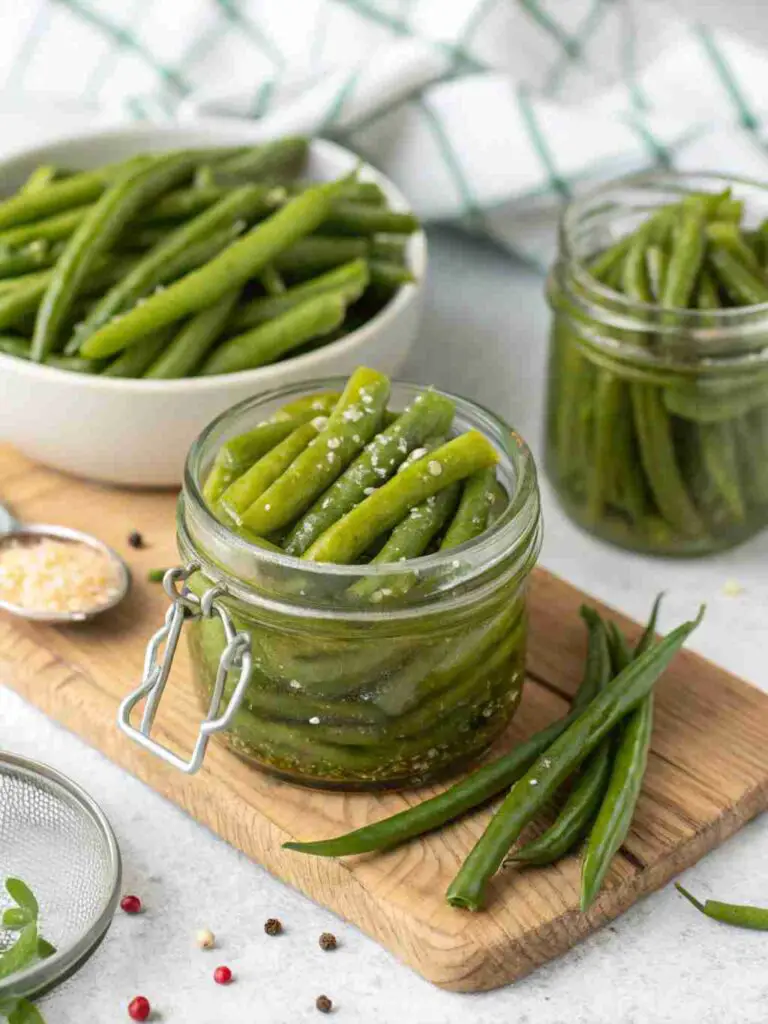Are you looking for a way to preserve the fresh taste of summer’s harvest? This guide provides you with everything you need to know about how to can Canned Green Beans safely and effectively using a pressure canner. Canning green beans is a fantastic way to enjoy their delicious flavor year-round while controlling the ingredients and avoiding store-bought preservatives. This comprehensive guide will walk you through each step, ensuring a successful and safe canning experience.
What are Canned Green Beans?
Canned green beans. Sounds straightforward, right? But have you ever wondered WHO decided this was the perfect way to preserve these crunchy little guys? Did some old-timey farmer accidentally drop a bushel of beans into a hot jar and think, “Eureka!”? Or did Grandma whisper a secret to generations about ‘catching’ the summer green bean flavor and keeping it secure for the winter?
Honestly, the origins might be lost to history, but one thing’s for sure: canned green beans are a kitchen staple, perfect for quick side dishes, hearty stews, or even a surprisingly tasty casserole — because remember, folks, ‘the way to a man’s heart is through his stomach!’ Ready to unlock the secrets of canning green beans? Let’s get started building that pantry!
Key Ingredients for Canning Green Beans:
Here’s what you’ll need to get started:
Fresh Green Beans: Choose 7 pounds of young, tender green beans. Wash them thoroughly and snap or cut them into 1-inch pieces.
Canning Salt: Exactly 3 1/2 teaspoons of pure canning salt (also called pickling salt), this is important for the flavor and preservation of the beans. Do not use iodized table salt.
Boiling Water: Enough to cover the beans in the jars, usually around 7 cups but have more in case of spillage. Be sure it is at a rolling boil.
Canning Jars: Use 7 pint-sized or 3-4 quart-sized canning jars with new lids and bands. Make sure jars are inspected for any cracks or chips.
Lemon Juice or White Vinegar: For quart jars only. 1 tbsp per quart is needed to ensure proper acidity.
How to Can Green Beans:
Canning green beans involves preparing your beans, then your jars, then filling the jars and pressure canning them for safe preservation. This recipe is simple, delicious, and rewarding, especially when you enjoy the fruits (or vegetables) of your labor months later! The prep time is about 20-30 minutes, and the canning process itself, especially the processing time, takes a few hours.
Step-by-Step Instructions:
Prepare the Green Beans: Wash the fresh green beans thoroughly under cold running water. Snap off the ends and discard any beans that are damaged and mushy. Cut the beans into 1-inch pieces, ensuring uniform sizes for even canning.
Prepare Canning Jars: Wash canning jars, lids, and bands. Jars need to be sterilized before canning. Sterilize your jars either by running them through a dishwasher cycle or by boiling them in a large pot of water for 10 minutes. Keep them warm until you’re ready to fill them. Sterilize lids and bands by simmering them in hot water. Do not boil the lids, as this can damage the sealing compound.
Pack the Green Beans: Pack the cut green beans into the hot, sterilized jars, leaving 1-inch of headspace (the space between the top of the food and the lid). Do not pack the beans too tightly; they need room for water to circulate during the canning process.
Add the Canning Salt and Acidity – Important: To each pint jar, add 1/2 teaspoon of canning salt. For quart jars, add 1 teaspoon of canning salt. If using quart jars, add 1 tablespoon of bottled lemon juice or 1 tablespoon of white vinegar. This is essential for ensuring adequate acidity for safe preservation, for quarts only. If using pint jars skip the vinegar/lemonjuice.
Add Boiling Water: Pour boiling water over the green beans in the jars, maintaining the 1-inch headspace. Remove any trapped air bubbles by running a plastic utensil or a bubble remover down the inside of the jar. If needed, add more boiling water to ensure the 1-inch headspace remains.
Wipe the Jar Rims: Use a clean, damp cloth to wipe the rims of the jars to ensure there are no food particles or residue that could prevent a proper seal.
Place Lids and Bands on Jars: Place the sterilized lids on the jars, positioning them carefully so they sit flat on the rim. Then, screw on the bands until they are fingertip tight – not too loose, not too tight. Over-tightening can prevent air from escaping during the canning process.
Load the Pressure Canner: Pour 2-3 inches of water into the pressure canner, following the manufacturer’s instructions. Place the filled jars on the rack inside the canner, being careful not to overcrowd them. Arrange them so that they do not touch each other or the sides of the canner.
Seal and Vent the Pressure Canner: Close the pressure canner lid securely, following the manufacturer’s instructions. Allow the canner to vent steam for 10 minutes to remove air. Once the canner is properly vented, close the vent.
Process the Green Beans: Process the green beans at 11 pounds of pressure (adjust for altitude if necessary) for the appropriate time, as directed below. Once the correct pressure is reached, start timing.
- Pints: 20 minutes
- Quarts: 25 minutes
Cool the Pressure Canner: After processing for the specified time, turn off the heat and allow the pressure to return to zero naturally. Do not force the cooling process or remove the vent weight prematurely.
Remove Jars and Cool: Once the canner is completely depressurized, carefully remove the lid. Use jar lifters to remove the jars from the canner, keeping them upright. Place the jars on a towel-lined surface, leaving space between them to allow for air circulation. Let the jars cool completely for 12-24 hours undisturbed.
Check the Seals: After the jars have cooled completely, check the seals. Press down on the center of each lid. If the lid does not flex or “pop,” it is properly sealed. If a lid flexes or pops, it has not sealed correctly and should be refrigerated immediately and used within a few days, or reprocessed with a new lid. Be careful when reprocessing as overprocessing can affect the texture.
Store the Canned Green Beans: Remove the bands from the sealed jars, wash the jars thoroughly, and label them with the date and contents. Store the jars in a cool, dark, and dry place. Properly canned green beans can be stored for up to one year!
Why You’ll Love This Canned Green Beans Recipe:
Imagine plucking perfectly crisp green beans right from your garden, transforming them into a pantry staple that will warm you through the winter. Canning green beans is the best way to capture fresh flavor, right in your own home. It’s not just about taste; it’s also a smart choice!
Buying canned beans can get expensive, but when you can green beans at home, you gain control over the ingredients and your budget! This method is the best way for you keep your garden-fresh and delicious beans to go with that hearty stew or Thanksgiving dinner.
What to Serve with Canned Green Beans:
Canned green beans are incredibly versatile. Here are some ways to bring out the flavors of your beans:
- As a Side Dish: Heat the green beans with a pat of butter, a sprinkle of salt, and a dash of pepper.
- In a Casserole: Use canned green beans as the foundation for a comforting green bean casserole, complete with cream of mushroom soup and crispy fried onions.
- With Roasted Meats: Serve alongside roasted chicken, pork, or beef for a complete and balanced meal.
- In a Salad: Add chilled canned green beans to a fresh salad for extra crunch and flavor.
- Alongside Mashed Potatoes and Gravy: A classic combination for a hearty and satisfying dinner.
Top Tips for Perfecting Your Canned Green Beans

- Choose Tender Beans: Select young, tender green beans that are free from blemishes and not overly mature. These will have the best texture and flavor after canning.
- Maintain Headspace: Always leave the recommended 1-inch headspace in each jar. This allows for proper sealing and prevents loss of liquid during processing.
- Adjust for Altitude: If you live at a high altitude, you will need to increase the processing time or pressure to achieve safe canning. Consult the USDA guidelines for specific adjustments.
- Use Canning Salt: Canning salt is pure sodium chloride without any additives like iodine or anti-caking agents, which can cloud the brine, darken the color, and affect the quality of canned goods.
- Ensure Proper Sealing: Always check the seals before storing the jars. A properly sealed jar will have a lid that is concave and firm.
Storing and Reheating Tips:
- Storage: Store your canned green beans in a cool, dark, and dry place, away from direct sunlight. Properly canned green beans can last for up to one year. Always inspect the jars before opening; do not use them if the seal is broken, the lid is bulging, or the contents appear discolored or have an off odor.
- Reheating: To reheat, simply drain the liquid and heat the green beans in a saucepan over medium heat until warmed through. You can also microwave them in a microwave-safe dish. Be careful not to overcook the reheated beans, as they are already cooked during the canning process.
- Freezing: Do not freeze canned green beans in the jar. This is a canning preservation method only.
Final Thoughts:
Canning green beans at home is a rewarding way to preserve the taste of summer and ensure you have delicious, healthy green beans available year-round. By following these steps and safety tips, you can enjoy the satisfaction of creating your own homemade canned goods. Grab your fresh green beans, gather your supplies, and get ready to fill your pantry with the goodness of canned green beans. Happy canning!
FAQs:
Q: Why do I need to use a pressure canner for green beans?
A: Green beans are a low-acid vegetable, meaning they do not have enough natural acidity to prevent the growth of Clostridium botulinum, the bacteria that causes botulism. Only a pressure canner can reach the high temperatures needed to kill these bacteria and ensure the beans are safe to eat.
Q: Can I use regular table salt instead of canning salt?
A: No, do not use table salt or iodized salt. These salts contain additives that can cause cloudiness and discoloration in the canned beans. Canning salt is pure sodium chloride without any additives.
Q: What if I don’t have enough beans to fill all the jars?
A: Only can full jars. If you don’t have enough beans, store them in the refrigerator for a couple of days and continue to add, or can them on another day. Alternatively you might want to make refrigerator pickled beans which have a delicious, tangy flavor that complements various dishes.
Q: How long will canned green beans last?
A: Properly canned green beans can last for up to one year when stored in a cool, dark, and dry place.
Q: What does pressure canning do for beans?
A: Pressure canning is a technique to create shelf-stable food by applying high temperature in a sealed vessel. This ensures that harmful microorganisms won’t spoil the beans while sitting on a shelf at room temperature for several months.
Q: What does headspace mean in canning?
A: Headspace is the space left in the jar for the food inside to expand. This is important so that when you process jars, the food doesn’t break the seal.
try also : Easy Pumpkin Dump Cake Recipe and find more in pinterest

